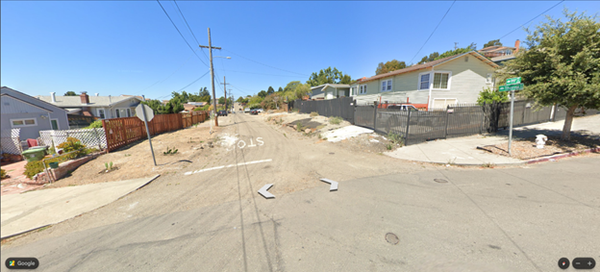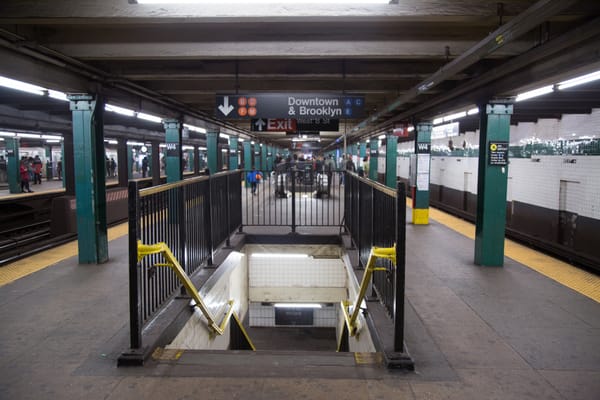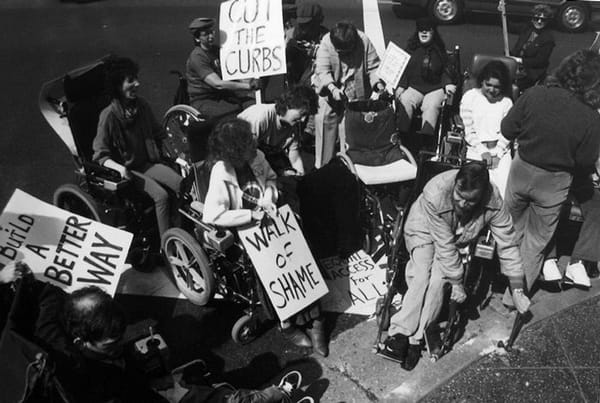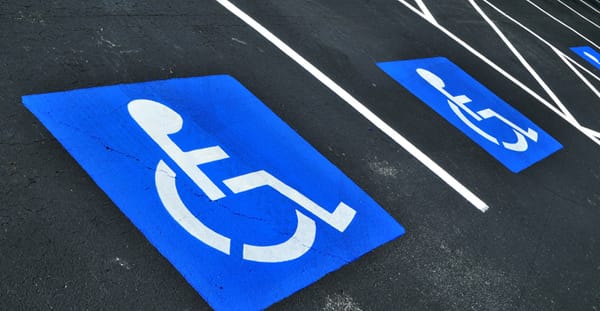7/28/25: Trump's Anti-Homeless, Anti-Disability EO Was Made Worse by NIMBYism
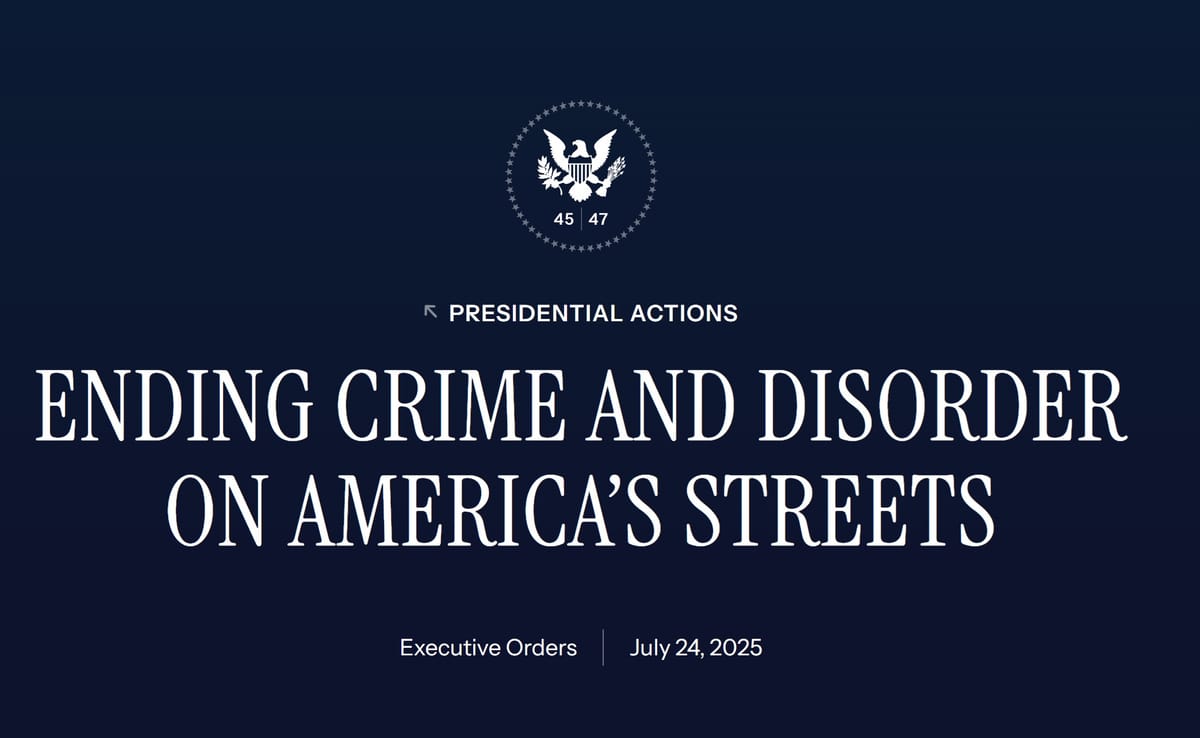
Note: I'm a bit overextended and will need to make these newsletters every-other-week for the next couple months. I'll also be trimming back the "in other news" section for the time being.
Saturday was the 35th anniversary of the Americans with Disabilities Act, the landmark disability rights law signed by George HW Bush in 1990 that paved the way for significantly better accessibility in the United States. So, it’s a cruel irony that Thursday, Donald Trump signed an Executive Order designed to institutionalize tens of thousands of people with disabilities (PWDs) here. Most outlets are referring to the EO as an effort to address homelessness or something that’ll institutionalize folks with mental illness. In reality, it’s much broader than that and sets us up to have our rights stripped away. Now, “us” mostly means PWDs, especially people with psychiatric disabilities – but the way the EO is written, anybody the administration disfavors could be labeled “mentally ill” and locked away without due process.
The Executive Order, titled “Ending Crime and Disorder on America’s Streets,” will do several things to attack the autonomy and well-being of homeless people and PWDs; further empower the President, Attorney General Pam Bondi, Housing and Urban Development (HUD) Secretary Scott Turner, and Health and Human Services (HHS) Secretary Robert F Kennedy, Jr.; and create a situation where the President or the HHS Sec. can persecute virtually anybody by labeling them mentally ill or addicted to drugs. Trump already accused many of his political enemies of having mental illness or being addicted to drugs, so that kind of weaponization of this EO isn’t out of the question.
Among other things, the EO does/aims to do the following:
– Encourage civil commitment and institutionalization of “individuals with mental illness who pose a danger to others or are living on the streets and cannot care for themselves,” which is a very broadly worded description that could easily be used against folks with a broad range of psychological disabilities, regardless of housing status.
– Direct resources and revise rules to more easily institutionalize “individuals who are a danger to themselves or others and suffer from serious mental illness or substance abuse disorder, or who are living on the streets and cannot care for themselves,” which is even more broadly worded than the bullet point above.
– Support encampment removal.
– Explore ways to ensure “that detainees with serious mental illness are not released into the public because of lack of forensic bed capacity at appropriate local, State, and Federal jails or hospitals,” which will almost certainly lead to people with psychological disabilities being kept in inadequate facilities, rather than significantly expanding the number of forensic beds.
– Pull federal funding from harm reduction efforts and safe consumption sites.
– Attempt to push people with “serious mental illness or addiction” who have gone through civil commitment off public programs and “into private housing and support networks.” Attempting to push people with serious mental illness off public services is a recipe for disaster that will only lead to higher rates of homelessness. Pushing people with substance use disorders off public services will likewise be destructive (perhaps marginally less destructive than when done for folks with serious mental illness, but destructive nonetheless…).
– Eliminate support for “Housing First” policies that attempt to put homeless folks into stable housing and provide wraparound supports until they can reach independence. Despite the EO claiming Housing First policies are ineffective, research finds their benefits outweigh the costs. They are also especially helpful for people with disabilities who would otherwise receive inadequate stability in a shelter or other congregate facility.
– Require that recipients of federal homelessness funding “collect health-related information” that the HUD secretary determines is “necessary to the effective and efficient operation of the funding program.”
– Require recipients of federal homelessness assistance funding “to share [health-related information] with law enforcement authorities,” which is a setup ripe for abuse.
Disability and homeless advocates are sounding the alarm over this Executive Order. A joint statement by six mental health and disability organizations points out that this EO is blatantly unconstitutional:
Kenneth Donaldson was locked up against his will in a Florida state hospital for fifteen years with scant basis when he brought a lawsuit challenging that confinement. The Supreme Court held that the hospital had violated Donaldson’s constitutional rights, noting that “the mere presence of mental illness does not disqualify a person from preferring his home to the comforts of an institution” and that “a State cannot constitutionally confine, without more, a nondangerous individual who is capable of surviving safely in freedom by himself or with the help of willing and responsible family members or friends.” The Court has reaffirmed these legal principles on multiple occasions. The government must uphold them.
Addressing the homelessness crisis for PWDs requires appropriate housing and services, not institutionalization. Michelle Uzeta, Interim Executive Director of the Disability Rights Education and Defense Fund (DREDF), shared on Facebook:
Instead of funding community-integrated, affordable, accessible housing with voluntary services and supports, and helping people who are struggling to make ends meet, the Trump Administration remains focused on punitive policies that are rooted in racist and ableist stereotypes.
Today’s Executive Order, combined with massive healthcare cuts the dismantling of federal offices that enforce civil rights and antidiscrimination laws, will not “restore order.” It will only make the homelessness crisis worse.
Most formal statements address the impact of this EO on unhoused people and those with psychological disabilities, but the way it’s written allows for broader persecution of all PWDs, many marginalized groups, and political enemies. Rebecca Cokley, a longtime disability advocate, posted on Facebook:
Folks, I keep seeing people limit this EO to "homeless" or "mental health" but I implore you read the language in it.
This is an ugly law. If you don't know what that means, google it.
This will be used against protestors. Against public demonstrations. Against Trans folks, people with any type of disability that can manifest itself or has symptoms that become apparent. It WILL be disproportionately used against Black and Brown communities, low income folks, and immigrants. It is another "legal" mechanism to disappear people.
Indeed, the vague language about mental health and substance use could be easily weaponized – and, if past is prologue, it will be used to disproportionately target marginalized communities (as Cokley says). This is a dangerous, dangerous Executive Order.
I must point out that this EO wouldn’t be nearly as effective without the US’s housing shortage, which of course has been supercharged by NIMBYism. The EO almost immediately mentions the 2024 national point-in-time count of unsheltered homeless people – 274,224, which was “the highest ever recorded” – to justify its draconian policies. (The rate of unsheltered homelessness per 100k population is actually lower than in 2007-08, though that’s nothing to brag about). If we had made progress on housing costs and homelessness in recent years, a) Donald Trump wouldn’t have as easy a time pointing to all the people on the streets to justify his crackdown and b) this draconian EO wouldn’t impact as many people, because fewer folks would be homeless. But instead, total homelessness has been increasing since 2018 and unsheltered homelessness has been on a steady rise since 2015. NIMBYism is largely to blame for the housing shortage; it’s a cruel irony that blue states have some the most acute housing shortages and highest rates of homelessness, meaning that Trump’s EO will hit people in blue states hardest.
The EO uses false stereotypes that drug use and dangerous mental illness because homelessness, suggesting that involuntary inpatient and outpatient treatment should get people off the streets. But the reality is that a lack of housing and supports causes homelessness. In the US, we are millions of homes short of where we should be; that exacerbates homelessness and has clear policy roots, from restrictive zoning to having arbitrary veto points for new development.
The Bipartisan Policy Center references the book Homelessness is a Housing Problem to note that:
[C]ities with large homeless populations tend to share specific characteristics:
– They have experienced significant population growth but have not added enough housing to meet the new demand, and-
– The increasing demand for housing amidst a constrained supply of homes reduces vacancy rates and increases rents, squeezing low-income and vulnerable populations out of the housing market and into homelessness. 3
The numbers support the thesis that housing constraints increase rates of homelessness. Again, from the BPC:
According to an estimate by Rosen Consulting, the U.S. underbuilt housing by 5.5 million and 6.8 million homes over the last 20 years.xi Such an acute housing shortage impacts low-income households the hardest: For every 100 low-income households (earning less than 80% of the area median income), just 55 homes were affordable and available. For very-low-income households (earning less than 50% of the area median income), there were just 36 homes.
Research by Zillow shows homelessness increases at a faster rate in places where people spend 32% or more of their income on housing on average, a signal that higher rents seem to drive increases in homelessness.xii

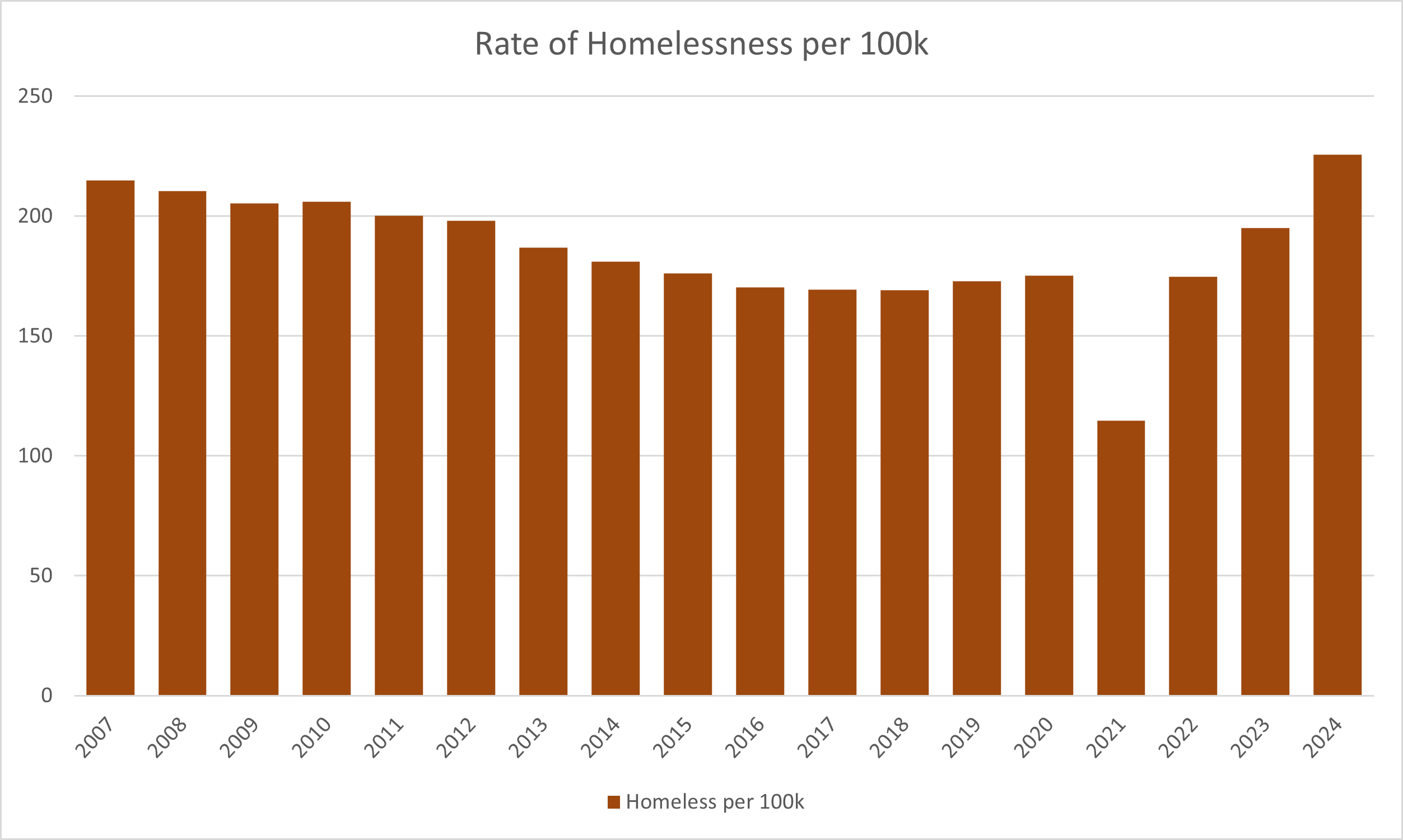
PWDs are an outsized share of low-income individuals and thus are more likely to get pushed onto the street in constrained housing markets. We also face additional headwinds that are difficult to manage on their own and are made worse by housing shortages. RISE, a Center for Independent Living in Sarasota County, Florida, lays some of those headwinds out in a joint article with the Saratoga County Alliance to End Homelessness:
For some homeless individuals, a disability can be a barrier to safe and affordable housing. A physical disability can prevent someone from seeking housing simply because they cannot obtain accessible transportation to view an apartment. For others, it’s the inability to obtain a reasonable accommodation to modify an existing unit and make it suitable for their needs. A mental, emotional, or learning disability may cause similar overwhelming feelings. A person’s inability to navigate complex paperwork due to a disabling condition often results in frustration, and the end result is often a feeling of defeat and the person giving up. Either way, to the person living with a disability, seeking independence can feel like climbing a mountain with a hundred pound weight on their back.
So, it's no surprise that estimates show roughly 40% of all homeless people have disabilities. NIMBYism also supercharges this problem by blocking newer apartment buildings, which are far more likely to be accessible than older apartments and single-family homes of all ages.
So, we have a situation where:
– People with disabilities are especially likely to become homeless due to a) the extra effort needed to find appropriate housing, b) a shortage of accessible housing, c) intellectual, psychological, and other disability-related difficulties when applying to housing, and d) our disproportionately low income.
– Once homeless, people often fall into drug use (e.g., taking uppers to stay awake and guard against violence), experience deteriorating health and new or exacerbated disabilities, or acquire psychiatric disabilities like post-traumatic stress disorder.
– Anti-development policies and NIMBYism exacerbate housing shortages and rates of homelessness, especially in blue states. The rate of unsheltered homelessness has been increasing steadily since 2015 and has become a highly visible crisis.
– Donald Trump is exploiting high rates of unsheltered homelessness to do a crackdown on unhoused people, folks with psychiatric disabilities – and potentially all people with disabilities, all disfavored groups, and the Administration’s political enemies.
This unconstitutional EO will undoubtedly be fought in the courts. But needless to say, it’s a dark anniversary for the ADA this year.
No In Other News this week. Sorry everyone…

